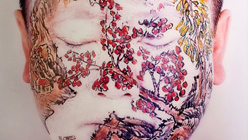The organizing principle around Rising Dragon, on view now through June 30, 2013, at the San Jose Museum of Art, is to showcase Chinese photographs produced between the last two Years of the Dragon, which occurred in 2000 and 2012. While that’s a perfectly fine curatorial framework, and the restricted timeframe is more than coincidentally relevant, the photographs in this show routinely transcend their shared vintage.
With more than 100 works by 36 artists from mainland China (sorry, Taiwan), the exhibition is a respectable introduction to contemporary Chinese photography. One of the first pictures we see is Spring by Huang Han, whose face is painted with flowering trees, mountains, and a small village, à la a traditional Chinese scroll painting. Han is one of several artists in the show whose body is his canvas, the other being Zhang Huan, who had a trio of calligraphers spend a day marking his face with family names and stories until his skin was jet black. For both artists, their place in Chinese society both informs and obscures their identity, although Huan literally comes to a darker conclusion than Han, as seen in the grid of nine progressive images of the artist’s face called Family Tree.

Maleonn (Ma Liang), Days on the Cotton Candy No. 1, 2006.
Nearby are several photographs by an artist who calls himself Maleonn, which is the phonetic spelling of his full name, Ma Liang. His pictures tell stories through their mixture of cross-cultural allusions, surrealism, and unabashed goofiness, all of which translates well to those of us schooled in Western visual vocabularies. In Days on the Cotton Candy No. 1, a young woman stands in a yellow, claw-foot bathtub while appearing to vacuum white cotton-candy-like clouds from the air, as if tidying up. Next to her is Maleonn’s Shanghai Boys, whose paramilitary costumes and eccentric poses amid purple stuffed reptiles seems a true hybrid of East and West.
Another pair of storytellers are Liyu + Liubo, who riff on China’s current crop of sensationalist tabloids, though they could just as easily be taking their inspiration from the breathless hysteria of Fox News or the bland improbability of The Onion. In each of the six examples on view, the artists concoct a deliberately bizarre headline (in one example, a thief chased until he crashes through the ceiling of an office building), and then illustrate the often silly results (the thief’s legs dangle above a conference table, interrupting a meeting already in progress).




